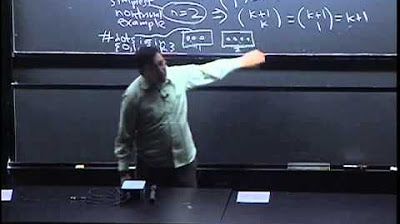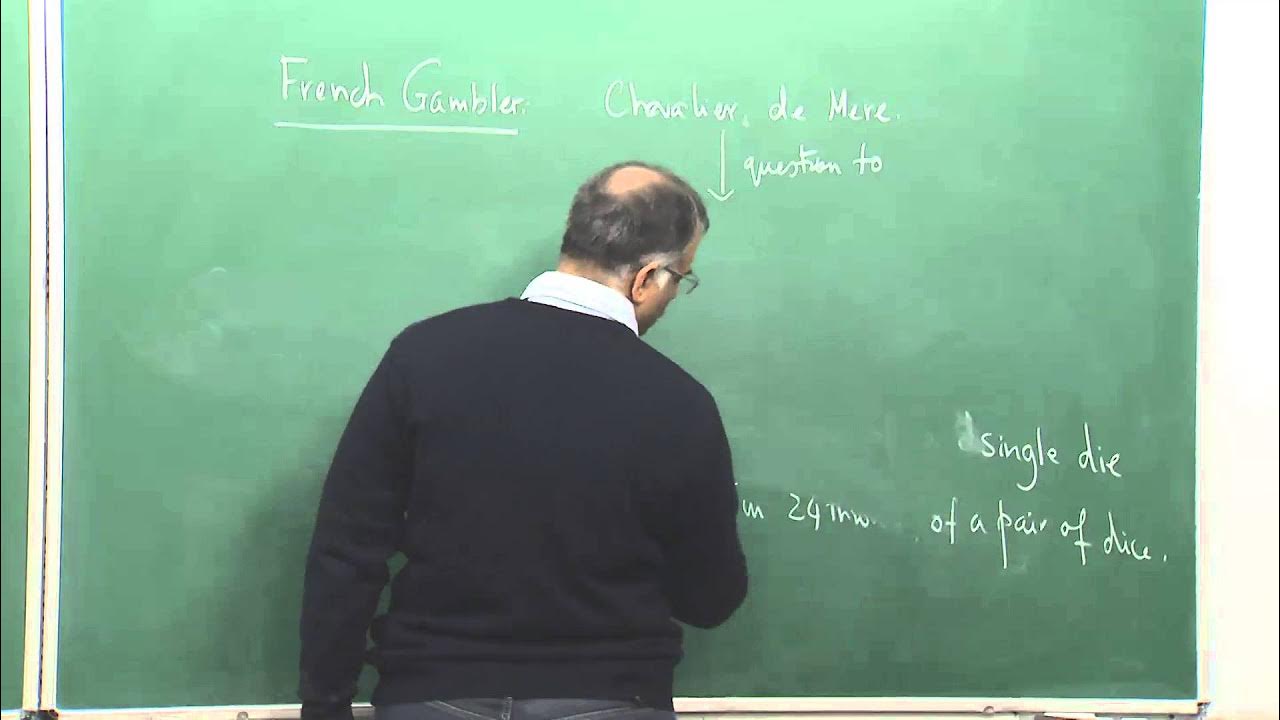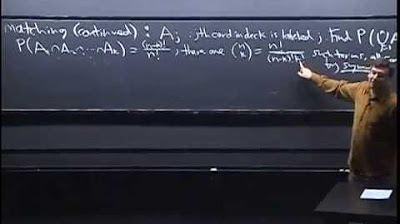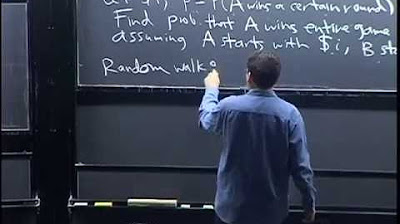Lecture 1: Probability and Counting | Statistics 110
TLDRThe speaker emphasizes the importance of strategic practice in mastering a difficult course, comparing the process to learning chess tactics. They discuss the structure of the course, which includes themed problem sets to improve pattern recognition, and stress the necessity of clarity and honesty in homework solutions. The speaker also addresses the grading policy, mentioning that late homework is not accepted and the two lowest scores will be dropped. They provide a brief overview of probability's applications in various fields, including history and gambling, and delve into the historical roots of probability, highlighting the correspondence between Fermat and Pascal. The lecture concludes with an introduction to the naive definition of probability and the concept of a sample space, setting the stage for further exploration into the logic of uncertainty that statistics provides.
Takeaways
- 📚 The course focuses on strategic practice, grouping problems by theme to help students practice specific topics effectively.
- 🤔 Pattern recognition is a crucial skill in the course, which improves with practice; thus, students are encouraged to solve as many problems as possible.
- 📉 The professor emphasizes clarity and honesty in homework submissions, advising against making up answers when unsure and preferring students to admit when they don't understand.
- 🚫 Avoiding sloppy work is important; the professor discourages submitting messy or incorrect solutions just to reach an answer.
- 💬 The course is about using both English and mathematical explanations, not just equations, to convey understanding and reasoning.
- 📅 Homework is due at the beginning of class, with no leeway for late submissions, and the professor drops the two lowest homework scores.
- 🧮 A math review handout is provided, and a review session is scheduled to help students refresh their mathematical knowledge.
- 🎓 The professor allows students to take the course pass/fail for flexibility, trusting them to decide what's best for their learning.
- 🎰 The historical roots of probability are in gambling, which is why it's justified to discuss gambling in the context of learning statistics.
- ⚖️ The naive definition of probability is introduced, which assumes all outcomes are equally likely and the sample space is finite.
- 🌳 The importance of counting principles, such as the multiplication rule, is highlighted for calculating probabilities and understanding combinatorics.
Q & A
What is the main focus of the course described in the transcript?
-The course focuses on strategic practice in problem-solving, with an emphasis on pattern recognition and the application of mathematical concepts across various topics. It also delves into the history and applications of probability, including its use in fields like history and social sciences.
Why does the speaker compare the course to learning chess tactics?
-The speaker uses the analogy of chess tactics to illustrate the importance of practicing individual strategies before combining them. This mirrors the course structure, where students start by practicing problems grouped by theme before moving on to more complex, mixed problems.
What is the significance of practicing a lot of problems in the course?
-Practicing a lot of problems is crucial for improving pattern recognition skills, which is a key aspect of the course. The more problems students solve, the better they become at recognizing patterns and solving complex issues.
How should students approach their homework in this course?
-Students should provide clear and detailed explanations using both words and equations. The speaker discourages sloppy or made-up solutions, preferring honesty and a clear justification for each step taken to arrive at the answer.
What is the role of the strategic practice problems in the course?
-The strategic practice problems serve as examples of the depth and style of work expected in homework assignments. They also help students to understand the topics in a structured manner and improve their problem-solving skills.
Why does the speaker mention the use of probability in history?
-The speaker cites the use of probability in historical analysis, such as the work by Mosteller and Wallace on The Federalist Papers, to demonstrate that probability has applications in less obvious fields. It shows that probability can be a valuable tool for understanding and resolving complex questions in various disciplines.
What is the 'naive definition' of probability mentioned in the transcript?
-The naive definition of probability is a basic way to calculate the probability of an event by dividing the number of favorable outcomes by the total number of possible outcomes, assuming that all outcomes are equally likely and that there are finitely many outcomes.
What is the sample space in the context of probability?
-A sample space is the set of all possible outcomes of an experiment. It is a fundamental concept in probability theory and can be applied to a wide range of scenarios, as long as there are certain possible outcomes that are unknown before the experiment is conducted.
What is the concept of an event in probability theory?
-An event is a subset of the sample space. It represents a particular outcome or a combination of outcomes that we are interested in within the set of all possible outcomes of an experiment.
Why is the use of set theory important in probability?
-Set theory is important in probability because it allows for the mathematical treatment of events as subsets. This mathematical precision is crucial for calculating probabilities and understanding the relationships between different events, such as through unions, intersections, and complements.
What is the multiplication rule in counting and how is it applied?
-The multiplication rule in counting states that if an experiment has n1 possible outcomes, and following each outcome of the first experiment there are n2 possible outcomes for a second experiment, and so on for r experiments, then the total number of possible outcomes for all experiments combined is n1 times n2 times ... times nr. It is visualized through tree diagrams and is fundamental for calculating probabilities in more complex scenarios.
How does the concept of 'with replacement' and 'without replacement' apply to sampling in probability?
-Sampling with replacement means that after an item is chosen from the population, it is returned so that it can be chosen again. Sampling without replacement means that once an item is chosen, it is not returned and cannot be chosen again. These concepts affect the number of possible ways a sample can be drawn and are important for calculating probabilities in sampling scenarios.
Outlines
📚 Strategic Practice and Course Structure
The speaker introduces the concept of strategic practice, comparing it to chess tactics training. Problems are grouped by theme to help students practice specific topics. The course focuses on pattern recognition, which improves with practice. The speaker emphasizes the importance of clarity, honesty, and using words and sentences in homework solutions, not just equations. They discourage guessing or making up answers and prefer students admit when they don't understand something. The solutions to strategic practice problems serve as examples of the quality of work expected. A math review handout is mentioned, and a review session is scheduled for Fridays at 2:00 in Hall E.
🗓️ Course Policies and Probability Applications
The speaker discusses course policies, including the due date for homework and the lack of leeway for late submissions. They mention dropping the two lowest homework scores and briefly touch on the various areas where probability is used, such as physics, quantum mechanics, genetics, and history. The speaker also talks about the option to take the course pass/fail and shares a story about a history concentrator who overcame his fear of math and went on to pursue a PhD in applying statistics to political science and history.
🎰 Probability's Historical Roots and Applications
The speaker delves into the historical roots of probability, originating from gambling. They mention famous mathematicians Fermat and Pascal, who developed probability theory by analyzing gambling games through correspondence. The course aims to teach students how to quantify uncertainty, which is applicable in various fields. The speaker also emphasizes the importance of mathematical precision in probability due to the potential for intuitive misunderstandings, even by great minds like Isaac Newton.
🤔 The Naive Definition of Probability
The speaker explains the naive definition of probability, which assumes all outcomes are equally likely and the sample space is finite. This definition involves dividing the number of favorable outcomes by the total number of possible outcomes. The speaker highlights the limitations of this definition, such as its inapplicability in cases where outcomes are not equally likely or when the sample space is infinite. They also discuss the importance of counting techniques in probability, introducing the multiplication rule as a fundamental principle for calculating the number of possible outcomes in a sequence of experiments.
🍦 Multiplication Rule and Ice Cream Example
The speaker illustrates the multiplication rule with a simple ice cream example, explaining how to calculate the total number of possible outcomes when choosing a type of cone and a flavor. They emphasize the importance of understanding this basic principle, as it underlies much of the counting techniques used in probability. The example demonstrates how the multiplication rule can be visualized using a tree diagram and how it leads to exponential growth in the number of possibilities with each additional choice.
🃏 Calculating the Probability of a Full House in Poker
The speaker provides an example of calculating the probability of getting a full house in poker. They explain the concept of a full house and how to use the naive definition of probability to find the probability. The calculation involves determining the number of ways to choose three cards of one rank and two of another from a standard deck of 52 cards. The speaker introduces the concept of combinations, represented by the binomial coefficient, and explains how to calculate the number of possible full house hands.
🔢 Sampling Methods and the Sampling Table
The speaker discusses different sampling methods, with and without replacement, and whether the order of selection matters. They introduce the sampling table, which outlines the number of ways to draw a sample based on these conditions. The speaker explains the calculations for each cell in the table, with the exception of the case where order matters and sampling is without replacement, which is a more complex calculation. They encourage students to practice counting techniques and to start working on the homework, which covers most of the material discussed.
Mindmap
Keywords
💡Strategic Practice
💡Pattern Recognition
💡Mathematical Class
💡Homework
💡
💡Sample Space
💡Event
💡Naive Definition of Probability
💡Counterintuitive
💡Binomial Coefficient
💡Full House
💡Multiplication Rule
Highlights
The course focuses on strategic practice, grouping problems by theme to help students practice specific topics.
The importance of pattern recognition in solving problems, which improves with practice.
The instructor emphasizes clarity and honesty in homework submissions, discouraging guesswork or random responses.
The use of words and sentences in mathematical explanations, even in a math class, to enhance understanding.
The homework is due at the beginning of class, with no leeway for late submissions.
The instructor drops the two lowest homework scores, encouraging students to attempt all problems.
A math review handout is provided, with updates made to it for students to download and review.
Review sessions are held on Fridays, which include a math review session that complements the handout.
The course allows for a pass/fail option for flexibility, trusting students to decide what's best for their learning.
Probability and statistics have applications in various fields including history, political science, and the humanities.
The historical roots of probability are in games of chance, such as gambling, which is discussed in the context of the course.
The course aims to teach the logic of uncertainty through statistics, contrasting with the logic of certainty in mathematics.
The naive definition of probability is introduced, based on the assumption that all outcomes are equally likely and the sample space is finite.
The concept of a sample space as the set of all possible outcomes of an experiment is discussed.
Events are introduced as subsets of the sample space, with the use of set theory being a breakthrough in probability.
The multiplication rule for counting is explained, which is fundamental for determining the number of possible outcomes in a sequence of experiments.
An ice cream example is used to illustrate the multiplication rule, making abstract counting principles more tangible.
The concept of a full house in poker is used as an example to calculate probabilities using the naive definition.
The binomial coefficient is introduced as a way to calculate combinations, which is crucial for counting problems in probability.
The sampling table is presented to differentiate between sampling with or without replacement and whether order matters.
The instructor encourages students to start the homework, as most of the necessary concepts have been covered.
Transcripts
Browse More Related Video
5.0 / 5 (0 votes)
Thanks for rating:





